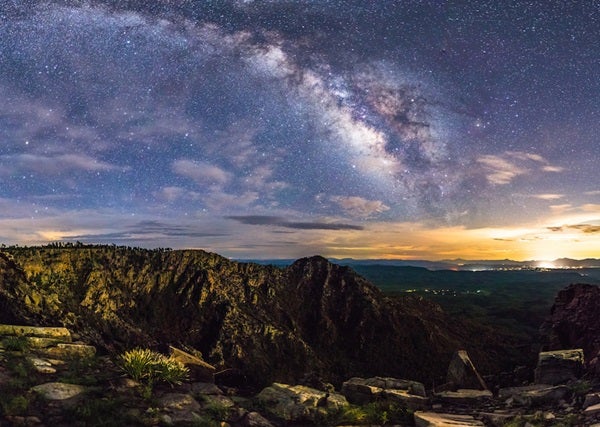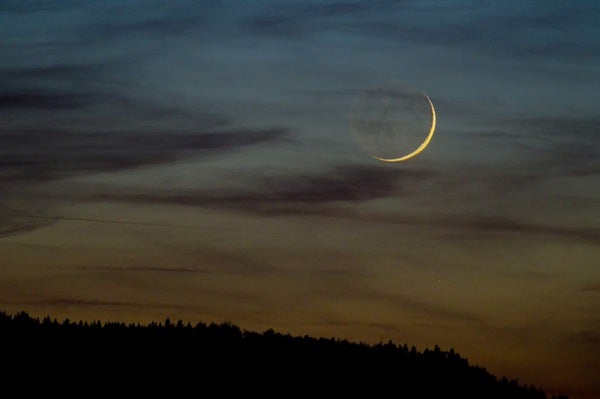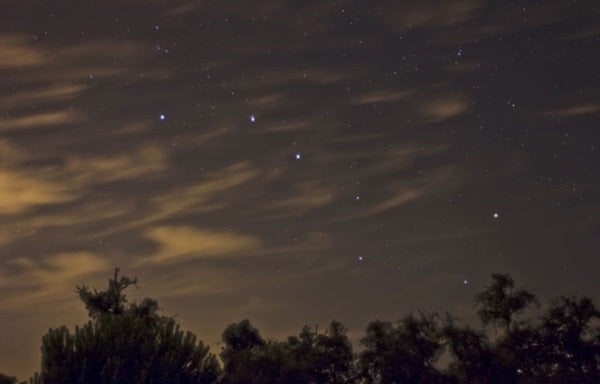Neptune reaches opposition and peak visibility tonight. Because it lies opposite the Sun in our sky, it rises at sunset and appears highest in the south around 1 a.m. local daylight time. But you can start searching for it by 10 p.m., when it stands nearly one-third of the way from the southeastern horizon to the zenith. Neptune glows at magnitude 7.8, bright enough to spot through binoculars if you know where to look. The trick is to find the 4th-magnitude star Phi (φ) Aquarii, which lies about 15° (two binocular fields) east-southeast of Aquarius’ distinctive Water Jar asterism. At opposition, Neptune appears 2.3° west-southwest of Phi. When viewed through a telescope, Neptune shows a blue-gray disk measuring 2.4″ across.
The Moon reaches perigee, the closest point in its orbit around Earth, at 9:20 p.m. EDT. It then lies 224,533 miles (361,351 kilometers) away from us.
Saturday, September 8
Observers using binoculars or a telescope should set their sights on Comet 21P/Giacobini-Zinner, which is making its second-best appearance since its discovery in 1900. The comet currently glows at 7th magnitude against the backdrop of Auriga the Charioteer, a region that rises in the evening and climbs high before dawn. Astroimagers will want to target Giacobini-Zinner these weekend mornings as it slides through a photogenic region of the winter Milky Way that includes the bright star clusters M36 and M38.
Sunday, September 9
New Moon occurs at 2:01 p.m. EDT. At its New phase, the Moon crosses the sky with the Sun and so remains hidden in our star’s glare.
Although you can’t see the New Moon, its absence from the morning sky these next two weeks provides observers with an excellent opportunity to view the zodiacal light. From the Northern Hemisphere, this time of year is the best for viewing the elusive glow before sunrise. It appears slightly fainter than the Milky Way, so you’ll need a clear moonless sky and an observing site located far from the city. Look for a cone-shaped glow that points nearly straight up from the eastern horizon shortly before morning twilight begins (around 5 a.m. local daylight time at mid-northern latitudes). The Moon remains out of the morning sky until September 23, when the waxing gibbous returns and overwhelms the much fainter zodiacal light.
Saturn appears nearly due south and at its highest altitude as darkness falls this week. The ringed planet shines at magnitude 0.4, more than a full magnitude brighter than any of the background stars in its host constellation, Sagittarius. If you own a telescope, there’s no better target than Saturn. Even the smallest instrument shows Saturn’s 17″-diameter disk surrounded by a dramatic ring system that spans 39″ and tilts 27° to our line of sight.
Tuesday, September 11
Any clear evening this week is a good time to explore the constellation Sagittarius the Archer. Not only does this star group harbor the incomparable Saturn, but it also hosts the central regions of the Milky Way. Sagittarius lies due south and at peak altitude around 9 p.m. local daylight time, near the time twilight ends. Notice that its brightest stars form a distinctive asterism in the shape of a teapot. To enjoy the Milky Way treasures, however, you’ll want to explore Sagittarius through binoculars or a telescope.
Wednesday, September 12
Venus dominates the twilight sky after sunset. The dazzling object shines at magnitude –4.7 among the background stars of southern Virgo. The planet stands 8° high 30 minutes after sundown and sets shortly after 8:30 p.m. local daylight time. A telescope reveals Venus’ disk, which spans 35″ and appears about one-third lit. This evening, you also can find the waxing crescent Moon hanging 9° above the planet.
Thursday, September 13
The Moon moves eastward relative to the background stars at an average rate of about 13° per day. This motion carries it to a position 4° to Jupiter’s upper right this evening. The pretty pair will be on display from twilight until Jupiter sets around 9:30 p.m. local daylight time. Of course, the giant planet remains a conspicuous object all week. It currently shines at magnitude –1.9 and dominates the southwestern sky after Venus sets. Jupiter resides among the background stars of Libra the Scales; this evening, it lies 4° due east of Zubenelgenubi (Alpha [α] Librae). If you view the planet through a telescope, its disk spans 34″ and displays spectacular cloud-top detail.
Friday, September 14
The constellations Ursa Major the Great Bear and Cassiopeia the Queen lie on opposite sides of the North Celestial Pole, so they pivot around the North Star (Polaris) throughout the course of the night and the year. In the first half of September, these two constellations appear equally high as darkness falls. You can find Ursa Major and its prominent asterism, the Big Dipper, about 30° above the northwestern horizon. Cassiopeia’s familiar W-shape, which currently lies on its side, appears the same height above the northeastern horizon. As the night progresses, Cassiopeia climbs above Polaris while the Big Dipper swings below it.
Uranus continues to climb higher in the late evening sky. The ice giant world lies in the southwestern corner of Aries, 12° south of the Ram’s brightest star, 2nd-magnitude Alpha (α) Arietis. At magnitude 5.7, Uranus glows brightly enough to see with the naked eye from under a dark sky, though binoculars make the task easier. To confirm a sighting, point your telescope at the suspected planet. Only Uranus shows a disk, which spans 3.7″ and sports a distinctive blue-green hue.
Sunday, September 16
First Quarter Moon arrives at 7:15 p.m. EDT. Our satellite rises in the southeast around 2 p.m. local daylight time, but it doesn’t become prominent until the Sun sets around 7 p.m. (The Moon then lies due south and about one-third of the way to the zenith.) After darkness falls, the Moon’s half-lit orb appears in southeastern Ophiuchus, to the right of Saturn and its host, Sagittarius the Archer.
Mars continues to put on a great show these September evenings. The Red Planet appears in the south-southeast as darkness falls and climbs highest in the south around 9:30 p.m. local daylight time. The world shines at magnitude –1.7, almost imperceptibly fainter than Jupiter. When seen through a telescope, surface features on the 18″-diameter disk continue to sharpen as the global dust storm dissipates. Mars currently lies among the dim background stars of southwestern Capricornus. And at 9 a.m. EDT today, the planet reaches perihelion — its closest approach to the Sun during its 1.88-year orbit — when it lies 128.4 million miles from our star.












